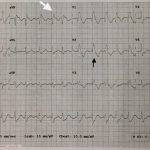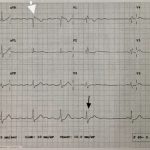Propafenone Overdose-induced Arrhythmia and Subsequent Correction After Administration of Sodium Bicarbonate
History of present illness:
71-year old woman presented to the emergency department with near-syncope, chest pain, and shortness of breath. She has a history of hypertension, congestive heart failure and an “irregular heartbeat.” She cannot remember what medications she takes. She recently saw her cardiologist and had some of her medications adjusted, but she can’t remember what specific changes were made. An electrocardiogram was performed, one ampule of sodium bicarbonate was administered and a repeat ECG obtained; patient felt improvement of her symptoms after administration of sodium bicarbonate.
Significant findings:
The first ECG in this case showed sinus tachycardia with a widened QRS (black arrow), a rightward axis, prolonged corrected QT interval (QTc), and terminal R wave in AVR (white arrow). There are several potential causes for these ECG findings, but put together with the patient’s history, we were suspicious of sodium channel blockers being the most likely cause. The second ECG, after sodium bicarbonate was administered, demonstrated a normal QRS (black arrow) and no rightward axis deviation, reduction of the QTC and resolution of the terminal R wave (white arrow). We later learned that the patient’s cardiologist recently increased her propafenone dose.
Discussion:
Propafenone is a class 1C anti-arrhythmic that slows influx of sodium ions into the cells. It slows the rate of increase of the action potential thereby prolonging conduction and refractoriness in all areas of the myocardium.1 The mortality from acute Class 1C toxicity has been reported as high as 22.5%.1 The degree of propafenone toxicity is directly correlated to the QRS interval,1 so monitoring said interval is very helpful in determining resolution of the drug’s cardiotoxic effects.
The electrocardiac effect of tricyclic antidepressants (TCAs) is a well-known and often tested finding. These effects include prolongation of the QRS and QTc, right axis deviation and a terminal R wave in AVR (an R wave greater than the S wave or an R wave greater than 3 mm). Similar ECG findings can be seen with cocaine,1 diphenhydramine,1 antipsychotics, and antidepressants toxicity. Sodium bicarbonate has proven to be a useful “antidote” for these and other sodium channel blocker overdoses. It is thought that sodium bicarbonate acts either to stabilize the myocardium or inactivate the drug itself.1 We believe this case further illustrates the value in administering sodium bicarbonate early in the course of suspected propafenone, and for that matter, all sodium channel blocker overdoses. One ampule of sodium bicarbonate is very safe and any downside to its use in the setting described above is most definitely outweighed by the almost immediate potential benefit seen after it is administered.
Topics:
Propafenone, sodium bicarbonate, overdose, ECG, sodium channel blocker.
References:
- Yeung A, Shanks D, Parwana H, Gin K. Acute propafenone toxicity after two exposures at standard dosing. Can J Cardiol.2010;26(6): e209-e210.
- Koppel C, Oberdisse U, Heinemeyer G. Clinical course and outcome in class IC antiarrythmic overdose. J Toxicol Clin Toxicol. 1990;28:433–44.
- Joglar JA, Hamdan MH, Page RL. Propafenone. Card Electrophysiol Rev.1998; 2:204–6.
- Miranda CH, Pazin-Filho A. Crack cocaine-induced cardiac conduction abnormalities are reversed by sodium bicarbonate infusion. Case Rep Med. 2013;396401:4-8. doi: 10.1136/bcr-2014-204599
- Abdi A, Rose E, Levine M. Diphenhydramine overdose with intraventricular conduction delay treated with hypertonic sodium bicarbonate and IV lipid emulsion. West J Emerg Med.2014;15(7):855-858. doi: 10.5811/westjem.2014.8.23407





